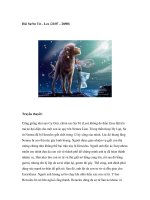music-history-placement-exam-preparation-guide-03.08.21
Bạn đang xem bản rút gọn của tài liệu. Xem và tải ngay bản đầy đủ của tài liệu tại đây (110.75 KB, 3 trang )
ANDREWS UNIVERSITY
SCHOOL OF GRADUATE STUDIES
DEPARTMENT OF MUSIC
Suggestions for the Preparation of the Graduate Placement Examination in Music History
Description of the Examination
The historical periods you will encounter on the exam are organized as follows:
1.
2.
3.
4.
5.
6.
Antiquity and Middle Ages (4th century B.C. – ca. 1440 A.D.)
Renaissance (ca. 1440 – ca. 1600)
Baroque and Pre-Classical (ca. 1600-1750)
Classical (ca. 1750 – ca. 1825)
Romantic (ca. 1825 – ca. 1890)
Impressionist and 20th-Century (ca. 1890 – ca. 1980)
There are seven separate parts to the music history exam, and you are required to complete each
part before moving on to the next:
• Parts 1-6 will test you over the six periods listed above. You will have 40
minutes to complete each part. Most of the questions in each part are in multiple
choice format, but you will also encounter a “choose the best TEN” (term, name,
composition) that is relevant to a given historical period. For example, if you were
to see “Brandenburg Concerto No. 5” listed in the section about the Romantic
period, you would not select it as one of the “best 10” because it was composed in
the Baroque period by J. S. Bach.
• Part 7 (score recognition) is set for one hour. In this section you will be given
seven excerpts from musical scores, selected from the historical periods covered
above. You will be required to indicate the stylistic period to which each one
belongs and provide two reasons to support your identification, based on specific
traits observable in the score.
NOTE: Part 1 is set for one hour to make sure you have enough time to get settled and make sure
your technology is working properly. This means you can have up to 5:20 hours for the music
history exam, which is more time than you should actually need to complete the exam.
Preparation for the Examination
A. Be able to recognize important musical terms, names, and compositions, and classify
them into one of the periods mentioned above. This aspect of the test consists mainly of
memorizing terms.
B. Review your music history course from the Greeks to the 20th century. Emphasis should
be put on characteristics of specific styles and the major contributions of important
schools of composition (such as Classicism, Impressionism, etc.) and principal
composers. Use the list of topics provided at the end of this document to guide you in
your preparation. The emphasis of this part is on the development of styles and genres
and contributions that key composers and stylistic schools made to them.
C. As you prepare for these topics, listen to representative works for each period while
following the score, and note distinctive characteristics for each genre (style, form,
instrumentation, etc.) This part of the exam involves recognizing genres and styles by
looking at a score, and determining an approximate time period. Only very characteristic
excerpts will be presented.
Suggested Study Tools
Some of the resources listed below are available on reserve at the Music Materials Center
(MMC) in Hamel Hall. Any good music history textbook, such as those on this list, will give you
a foundation and illustrations to prepare you for the placement exam. Remember to study a score
anthology along with a textbook. Inquire about CDs to accompany the score anthologies if you
borrow from the MMC.
• Barbara Russano Hanning, Concise History of Western Music (any edition): published by
W. W. Norton and based on Burkholder/Grout/Palisca, A History of Western Music (This
textbook corresponds also with the Norton Anthology of Western Music.)
• J. Peter Burkholder, Donald Jay Grout, and Claude V. Palisca, A History of Western
Music (any edition, but the most recent is the 10th edition)
• J. Peter Burkholder and Claude V. Palisca, eds., Norton Anthology of Western Music,
three volumes (Any edition is fine, although it would make sense to select the edition that
accompanies the textbook you have chosen—but note that the editions may not
correspond exactly. For example, the 9th edition of A History of Western Music
corresponds with the 7th edition of the Norton Anthology of Western Music.)
• K. Marie Stolba, The Development of Western Music: A History
• K. Marie Stolba, ed. The Development of Western Music: An Anthology
• Craig M. Wright, Music in Western Civilization (older editions are in 2-3 volumes)
• Timothy Roden, Anthology for Music in Western Civilization
• Richard Taruskin and Christopher H. Gibbs, The Oxford History of Western Music,
College Edition
• Milo Wold, An Outline History of Western Music
Suggested Topics
• The Greek Doctrine of Ethos
• Gregorian Chant
• Polyphonic Music from 900-1300
• Development of the Mass (Medieval and Renaissance: 14th-16th centuries)
• Development of the Motet (13th to 16th centuries)
• Development of Secular Music (Medieval to Renaissance: 14th to 16th centuries)
• Development of Instrumental Music (Renaissance to Baroque)
• The Lutheran Chorale and Its Use in German Music of the Baroque (especially in the
music of J. S. Bach)
• The Florentine Camerata, Monody, and Early Opera (17th century)
• Cantata and Oratorio in the Baroque
• Development of the Sonata (Classical, into the 19th century; for the Classical sonata,
emphasis on the formal structure)
• Development of the Symphony (18th century)
•
•
•
•
•
•
•
•
•
•
Development of Chamber Music (18th to 20th centuries; emphasis on the string quartet)
Development of the Concerto (concerto grosso, solo concerto, 19th-20th-century concerto)
Opera and Oratorio (from the 18th to the 20th century)
The 19th-century Lied (art song), including aspects of piano accompaniment
Character Pieces for Piano in the Romantic Period
The Romantic Symphony and Tone Poem; the 20th-Century Symphony
Choral Music in the 19th Century (sacred and secular)
Program Music
Nationalistic Trends in Music of the 19th and 20th Centuries
20th-Century Currents (be familiar with representative composers and important works):
Post-Romanticism
Gebrauchsmusik
Second Viennese School
Impressionism
Twelve-tone music Avant-garde music
Expressionism
Primitivism
Electronic music
Neo-Classicism
Musique concrète
Minimalism
rev. 03.08.21









